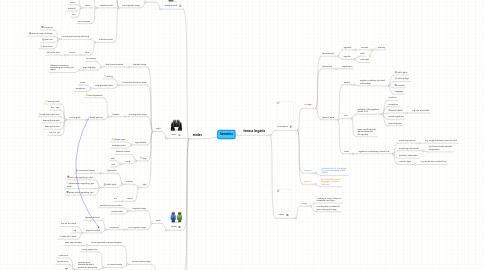
1. famous linguists
1.1. de Saussure
1.1.1. a sign
1.1.1.1. two elements
1.1.1.1.1. signified
1.1.1.1.2. signifier
1.1.1.2. relationship
1.1.1.2.1. signification
1.1.1.3. types of signs
1.1.1.3.1. symbol
1.1.1.3.2. icon
1.1.1.3.3. index
1.1.2. "langue"
1.1.2.1. not visual part of a language, the inner knowledge of the system
1.1.3. "parole"
1.1.3.1. the perceptible part of language, a concret statement
1.2. Peirce
1.2.1. a sign
1.2.1.1. "nothing is a sign unless it is interpreted as a sign"
1.2.1.2. an interpreter is needed to give meaning to a sign
2. modes
2.1. auditory-vocal
2.1.1. sound
2.1.1.1. linguistic usage
2.1.1.1.1. speech (as a primary manifestation of language)
2.1.1.2. non-linguistic usage
2.1.1.2.1. physiological reflexes
2.1.1.2.2. musical effects
2.1.1.2.3. voice quality
2.1.1.2.4. natural sounds
2.1.1.2.5. artificial sounds
2.2. visual
2.2.1. sight
2.2.1.1. linguistic usage
2.2.1.1.1. deaf communication
2.2.1.2. historically derivative usage
2.2.1.2.1. writing
2.2.1.2.2. writing based codes
2.2.1.3. non-linguistic usage
2.2.1.3.1. kinesies
2.2.1.4. signs/shields
2.2.1.4.1. danger signs
2.2.1.4.2. emergency exit
2.2.1.5. flags
2.2.1.5.1. different nations
2.2.1.5.2. racing
2.2.1.6. light
2.2.1.6.1. artificial
2.2.1.6.2. natural
2.3. tactile
2.3.1. touch
2.3.1.1. linguistic usage
2.3.1.1.1. deaf-blind communication
2.3.1.1.2. secret codes
2.3.1.2. non-linguistic usage
2.3.1.2.1. proxemics
2.4. olfactory
2.4.1. smell
2.4.1.1. communicative usage
2.4.1.1.1. more important in animal kingdom
2.4.1.1.2. in human society
2.4.1.2. non-linguistic usage
2.4.1.2.1. reception of information about the outside world
2.5. gustatory
2.5.1. taste
2.5.1.1. non-linguistic usage
2.5.1.1.1. reception of information about the outside world
2.5.1.2. communicative usage more important in animal kingdom
2.5.1.2.1. dogs use it to mark their territory
